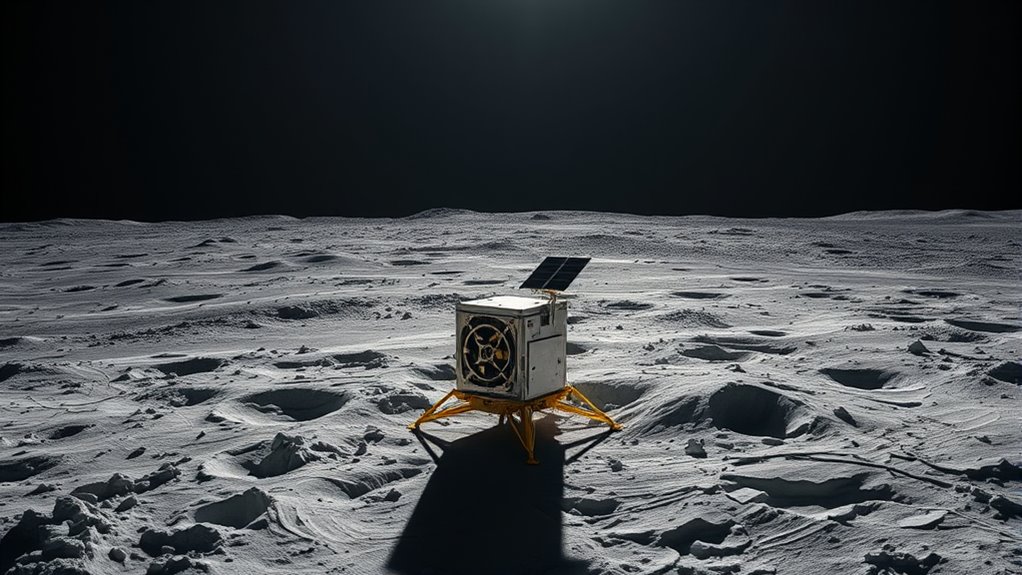India’s Chandrayaan-3 has achieved a historic milestone by landing on the Moon’s south pole, marking the first exploration of this uncharted region. This success demonstrates advancements in space technology, precise engineering, and international collaboration. It expands our understanding of the lunar surface, resources, and potential for future missions. This remarkable achievement not only boosts India’s space capabilities but also inspires global progress in lunar exploration—continue to explore to learn more about this incredible feat.
Key Takeaways
- Chandrayaan-3 achieved a historic landing on the Moon’s south pole, marking India’s first exploration of this uncharted lunar region.
- The mission demonstrates advanced engineering, precise navigation, and sophisticated scientific instruments for lunar surface analysis.
- It expands global understanding of lunar resources, including water ice and mineral composition, aiding future scientific studies.
- The successful landing symbolizes a major national achievement for India and inspires future space exploration endeavors.
- The mission highlights international collaboration and technological innovation driving humanity’s exploration of challenging terrains.

India’s Chandrayaan-3 has achieved a historic milestone by successfully landing on the Moon’s south pole, a region previously unexplored by any spacecraft. This achievement marks a significant leap in space exploration, demonstrating how dedicated effort and cutting-edge technology can open new frontiers. As you follow this historic event, you realize that this landing isn’t just a national achievement for India; it’s a testament to humanity’s relentless pursuit of knowledge beyond Earth. The mission’s success showcases the power of technological innovation, illustrating how advancements in engineering, navigation, and scientific instruments make such complex endeavors possible. Chandrayaan-3’s landing on an uncharted lunar region highlights the importance of pushing boundaries in space exploration, inspiring future missions to venture into even more challenging terrains.
Space exploration has always been about more than just reaching new worlds; it’s about expanding our understanding of the universe, discovering resources, and answering fundamental questions about the origins of our solar system. The successful landing on the Moon’s south pole demonstrates that technological innovation is essential in overcoming the many hurdles of lunar exploration. From precise landing techniques to advanced communication systems, every component of Chandrayaan-3 was designed to operate in one of the most inhospitable environments known to humanity. Regular maintenance of spacecraft systems, including calibration and system checks, is crucial for mission success in such extreme conditions. This achievement not only enhances India’s position in space research but also fuels global interest in lunar exploration, pushing other nations to develop their own ambitious plans. Technological innovation continues to be a driving force behind breakthroughs in space missions worldwide.
You realize that the mission’s success underscores the importance of cutting-edge technology in enabling exploration of otherwise inaccessible regions. As you watch the spacecraft settle on the lunar surface, you realize that this moment signifies more than just a successful mission; it’s a symbol of what can be achieved through relentless innovation. The mission’s technological advancements pave the way for future lunar and planetary exploration, enabling scientists to study the Moon’s surface, uncover hidden water ice, and analyze mineral compositions. Advanced engineering played a vital role in ensuring the spacecraft’s precise landing and safe operation in the lunar environment. The success of Chandrayaan-3 also underscores how international collaboration and shared knowledge drive progress in space exploration. With each milestone, you see how technological innovation accelerates humanity’s ability to explore the cosmos, transforming once-impossible dreams into tangible achievements. This historic landing on the Moon’s south pole proves that with dedication, ingenuity, and cutting-edge technology, you can reach uncharted territories and expand the horizons of human knowledge.
Frequently Asked Questions
What Scientific Instruments Are Onboard Chandrayaan-3?
You’ll find that Chandrayaan-3 carries several scientific payloads, including a seismometer, thermal probe, and a spectrometer. These instruments help analyze lunar soil, temperature, and seismic activity. During your mission, you’ll need to guarantee proper instrument calibration for accurate data collection. The payloads work together to study the moon’s surface and subsurface, providing valuable insights into lunar geology and helping you understand the moon’s environment better.
How Does Chandrayaan-3’s Landing Compare to Other Lunar Missions?
Your question about Chandrayaan-3’s landing compares it to other lunar missions by highlighting its remarkable landing precision at the Moon’s south pole. This achievement marks a significant mission milestone, as few missions have targeted such challenging terrain with so much accuracy. Unlike earlier missions, Chandrayaan-3 demonstrates advanced landing technology, paving the way for future exploration and scientific discoveries, making it a historic step forward in lunar exploration.
What Challenges Did ISRO Face During Chandrayaan-3’s Development?
You’re facing a tall order with ISRO’s Chandrayaan-3. Funding constraints posed significant hurdles, threatening delays and design compromises. Technical challenges, like developing precise landing technology for the lunar south pole, kept you on your toes. Yet, through perseverance, you overcame these obstacles, demonstrating that even under pressure, determination can turn dreams into reality. The mission’s success proves that with grit, you can conquer the toughest of challenges.
How Will the Mission Benefit Future Lunar Exploration?
Your understanding of how the mission benefits future lunar exploration is vital. By exploring the lunar south pole, you help advance lunar resource utilization, revealing potential resources like water ice for future missions. Additionally, the mission emphasizes planetary protection, ensuring that exploration minimizes contamination risks. These efforts pave the way for sustainable, safe, and more efficient lunar missions, inspiring global collaboration and technological innovations that benefit future space endeavors.
What Is the Long-Term Plan for India’s Lunar Program?
Your long-term plan for India’s lunar program focuses on advancing its space policy by fostering international collaboration and building sustainable lunar exploration. You’ll see India aiming to develop more sophisticated missions, including potential lunar bases and resource utilization. The goal is to establish India as a key player in space exploration, working closely with global partners to share knowledge, technology, and data, ensuring a lasting presence on the Moon.
Conclusion
You’ve witnessed a wondrous win for India’s space program, as Chandrayaan-3 charmfully challenges the cosmos with courage and curiosity. This historic hop to the moon’s south pole symbolizes scientific spirit and societal success. With wonder and will, India’s initiative inspires innovation and ignites imaginations worldwide. Celebrate this celestial milestone, marking mankind’s marvelous march into the mysterious, moonlit marvels of the universe. Truly, a declaration to tenacity, teamwork, and technological triumph!









